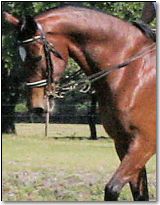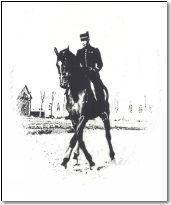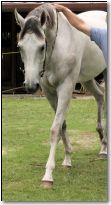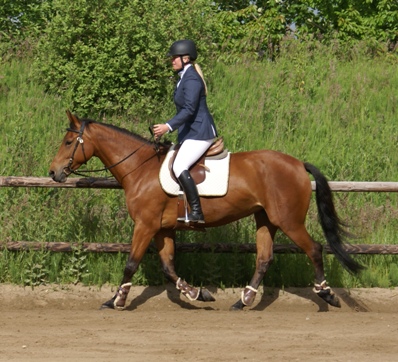Greetings!
Jean Luc and I want to thank the many of our members for signing the Ban the Rollkur petition as well as sending to others. As of this writing we have over 1,300 signitures!
For those of you interested in continuing helping a few suggestions. If you Twitter or use any soical media, forums, or blogs post the petition. You can make a difference!
Jean Luc will be teaching a clinic Dec 5th and 6th at the beautful Clermark Equestrian farm in Bradenton Florida. Contact information is below. If you are in Florida this is your chance to learn and experiece the science in riding. Jean Luc creates great riders. He teaches how to analyze the horse's difficulties and how to implement the solutions.
Nickers Communications is now selling our DVD " The Horse That Could Not Trot". they also will be handling wholesale orders. If you are selling items on your website and/or have a store contact :
Director of Consumer Sales
Nicker Communication
Phone/Fax (805) 482-5038
Jean Luc is in Arkon,Ohio this weekend at Light By Night farms, 330.671.0627 lbnfarm@hotmail.com
The Blog page on Science Of Motion, we would love to see some activity, and hope you will get involved. If you have any questions on usage/how to's contact us. |
|
Hyper-Flexion
 A Canadian friend was telling about the horrible spectacle of a western trainer who slammed his horse onto the ground and then placing a foot on the horse head was lighting up a cigarette proud of his domination. Blinded by his pathetic ego the man was not even capable to realize that his demonstration was showing the magnitude of his intellectual deficiency rather than his skill. The same pity arises from interviews of riders overstressing the upper half of their horse neck, which does not have enough muscle mass or ligament to support the stress and try to explain that their horse loves it. The spectacle of the "blue tong video" is horrific. The horse's tongue is dead, the horse's brain is dead and from the view from behind at the canter, the hocks are dead too. All problems result from the hyper-flexion of the upper neck. The horse upper neck is very weak. The horse does not have the capacity to oppose great resistance nor support much stress in this area of the neck. Once trapped in hyper-flexion the horse has no way out. The sole defense mechanism left is shutting off the brain and survives the abuse. |
|
Hyper-Flexion of the upper neck-A failure of Olympic dimensions
The nuchal ligament is an elastic structure inserted at one end on the dorsal spinous process of the fourth thoracic vertebra and attached at the other end on the cervical vertebrae and the skull.
. 
The general consensus is that the nuchal ligament supports the head in an alert position, yet stretches enough to allow grazing. In reality, the nuchal ligament is not under tension when the horse holds the head and neck in an alert posture. At the other extreme, the nuchal ligament is not elastic enough to allow grazing. Instead of the support role theorized by traditional anatomists, the purpose of the nuchal ligament is to assist the work of the upper neck muscles. At the walk, the nuchal ligament provides 55% of the energy needed to move the head and neck. At the trot and canter, the nuchal ligament assumes 33% and 31% respectively of the total work required to oscillate the head and neck. By taking advantage of the nuchal ligament's energy storage capacity, the horse reduces the work of the upper neck muscles between 31% and 55% at the different gaits.

 The head and neck carriage commonly presented at FEI dressage level is totally assumed by the work of the upper neck muscles. The nuchal ligament is then almost totally unstrained. "At a neck angle of 55�all portions of the nuchal ligament are unstrained." (K. S. Gellman, J. E. A. Bertram, The Equine Nuchal Ligament: Structural and Materials Properties, 2002). The lowering of the neck that the horse spontaneously executes after work is not a stretching of the upper neck muscles as emphasized by traditional anatomist, but rather an astute way to ease the work of the upper neck muscles, thereby increasing the contribution of the nuchal ligament. |
Susan Kjaergard
Refusals can be perfectly all right.
For show jumping riders it is very important that the horses do not stop in front of the jumps but learn to jump no matter what type of scary and colourful jumps the course designer has come up with.
But is it enough just to jump or is it important HOW the horse jumps the fence?
And are we maybe hindering our future wish to produce clear rounds and win prices if we focus too much on the horse not refusing to jump in the beginning of its jumping and show career??
The writer of this article thinks so and that's why she very often allows the young horses to refuse at the jumps for the very first couple of horse shows.
|
|
Host A Clinic
 Since preventing a problem is less costly than repairing lameness, Jean Luc's lessons can save you thousands of dollars. Clinics and Symposia can be organized separately or conjointly. Clinics Clinics are usually week-end events: Friday, Saturday, and/or Sunday. (Minimum 2 days.) A traditional clinic day is 8 private 1-hour lessons. Jean Luc's analytic approach is best served with private lessons. However, for the study of a specific movement, group lessons with 2 or 3 riders are accepted. Auditor fee is at the discretion and profit of the clinic host. | |
|
A special thank you to Carolyn Sanchez who edits Jean Luc writings and so much more. Jean Luc and her horse Louis will be teaming together at Clermark Equestrain Horses and Holly for an in-hand demostration.
Jean Luc and I would love to hear from you, send us an email.
Enjoy The Journey,
Helyn and Jean Luc
Editor Helyn Cornille
Science Of Motion |
Jean Luc Cornille has gained worldwide recognition by applying practical science to the training of the equine athlete. Influenced by his background as a gymnast, Jean Luc deeply understands how equine training can be enhanced by contemporary scientific research. A unique combination of riding skill, training experience and extensive knowledge of the equine physiology enables Jean Luc to "translate" scientific insights into a language comprehensible to both horse and rider. This approach has been the trademark of his training. |
|
|
|
Featured Email
Dear Helyn and Jean Luc,
I am emailing you to thank you for the much inspiration I've been getting through your website and for the great job you both do in educating people and enabling them to improve soundness and welfare for their horses.
I signed your petition on the ban for Rollkur, since I've been working against it for as much as possible here in Denmark. I've been working with the 2 journalists from Epona.tv that documented the Blue Tongue and, at a great personal expense, I participated in a Danish tv show (sports program) that documented the use of Rollkur in professional sports.
Being a former top 100 showjumping rider of the FEI worldranking list and a member of the Danish national team, many of the poor examples in the tv show were former close colleagues and off course they were all very upset, because the hyperflexion is SO common that almost NO ONE rides properly anymore. Through my process of educating myself and learning more about the anatomy and biomechanics of the horse I have been chocked to realise HOW poorly we educate and treat competition horses L Though I was known as a very sympathetigue rider and have received awards for great horsemanship at top level I also trained in draw reins and with the horses noses tugged in (not as drastically as P Kittel in the video, but still) because that was the way to do if you wanted ribbons.
I am now on a path trying to produce a group of competition horses (showjumpers) that can perform with hopefully no or very little stress and tension. I am trying to take a very different route and for example I'm bringing young horses to shows only riding in the warm up area or entering a class without jumping, only to make them quiet and comfortable in the ring. In Denmark we don't have very many regular practise shows so this must be done at the smallest regular shows, but still creating quite a fuzz. It's quite interesting how the lack of nosebands, loose or soft reins and treats in the showring can facilitate aggressive behaviour from other riders ;-) (see attached photo of a 4-year-old in a warm up ring)
At the 2009 ISES conference in Sydney I gave a speech about my journey into a different (better/more ethical) way of riding. How we actually remove ourselves further away from the goal of producing clear rounds by hyperflexing the horses and installing a deep association between the flight response and the jumps, when we push to hard to avoid refusals in the beginning of their career. I've attached an article that I've written about the subject of horses that run in the showring if you are interested in reading it. Please bear with me in regards to grammar and spelling ;-)
Through my latest work I've encountered many horses that seem to have been rushing to the jumps due to more physical reasons though. I work closely with a Danish vet and a very competent equine chiropractor and I've been successfully retraining horses with soundness issues, getting them fit, sound and performing well. Some of them have not seen a jump for many months where we've been doing ground work and retraining with poles; on the lunge line and light work under saddle in a long frame and when they finally get back into jumping, the running issues are drastically reduced and in some cases completely gone even though there has been no actual training other than improving physical capability.
Anyways, I did not intend to make this email all about me (but did anyway) I again really want to thank you for the great work that you do and let you know that you inspire many many riders and horse trainers around the world. The horses truly need people like you and I hope to be able to participate in a clinic and meet you at some point.
Very best regards
Susan Kj�rg�rd
|
Upcoming Clinics
New Hamshire
November 29th & 30th
Black Magic Farms-NH
Gail Harrington has been
studying the biomechanics of training the equine athlete with Jean Luc since 1985 on her equine partners Formal Affair, Munnings, Black Magic, Dwina,
Waltzman, and Rambo. Black Magic
blackmagic54@comcast.net
Dec 5th-6th Clermark Equestrian
|
|
DVD-Video
The Horse That Could Not Trot" Jan Luc Cornille
The video shows the interactions between lateroflexion and transversal rotation of the cranial thoracic vertebrae. Through animations you can visualize the difference between proper and inverted rotation. The practical application in the dressage ring clearly exposes the difference between a gymnastic exercise such as the shoulder-in, practiced with the horse's vertebral column properly coordinated by contrast with the same gymnastic exercise practiced by the same horse but with the vertebral column combining lateral bending and inverted rotation.
|
|
Equine Guest Speaker
Jean Luc Cornille
Professional public speaker, lecturer Jean Luc Cornille is available worldwide for events/seminars.
Jean Luc Cornille has a lifetime of experiences with horses to share in an engaging lecture style. From his teen years exercising race horses, his classical education in the Cadre Noir de Saumur, and studies with many of Europe's great trainers in both dressage and jumping, Jean Luc has a wealth of anecdotes that have fascinated, educated, and entertained his many students around the globe. As he competed at international level events in 3-day eventing, show-jumping and dressage, and coached others to the Olympic levels, he sought answers to the difficult questions that arose in training, soundness and performance. His quest lead him to the science of biomechanics of the horse, and he excels at "translating" the most updated scientific knowledge into usefull information for the equestrian. He speaks of horses with both authority and sensitivity, and always, his passion for the well-being of the horse.
|
|
|